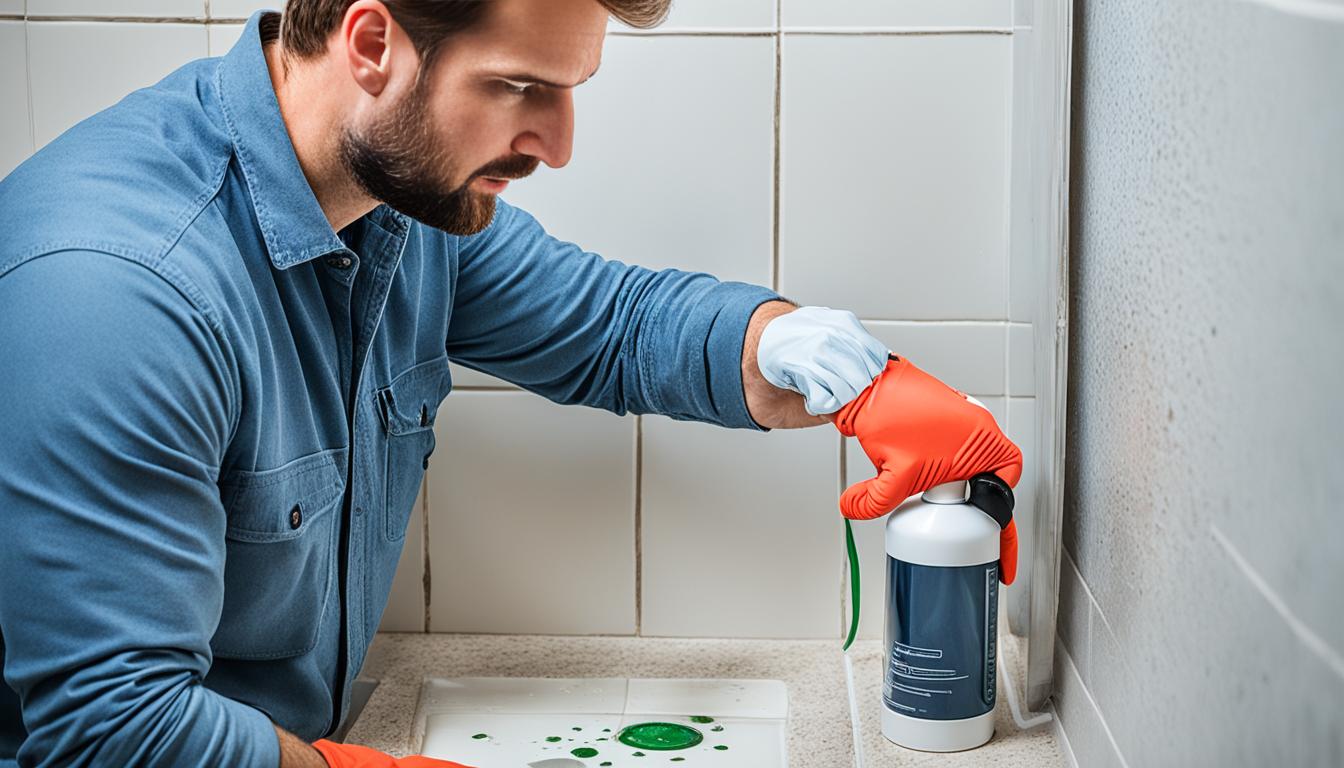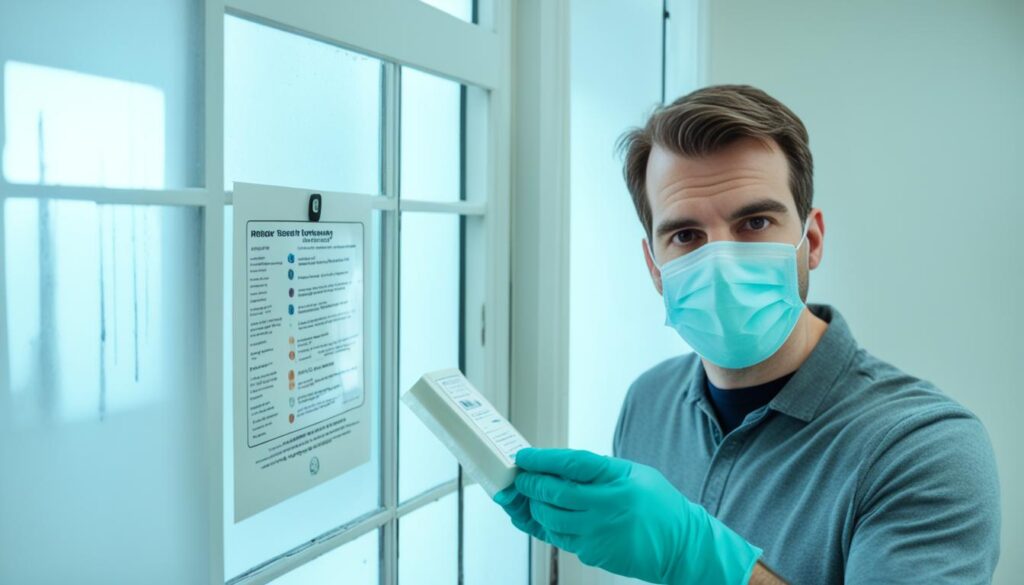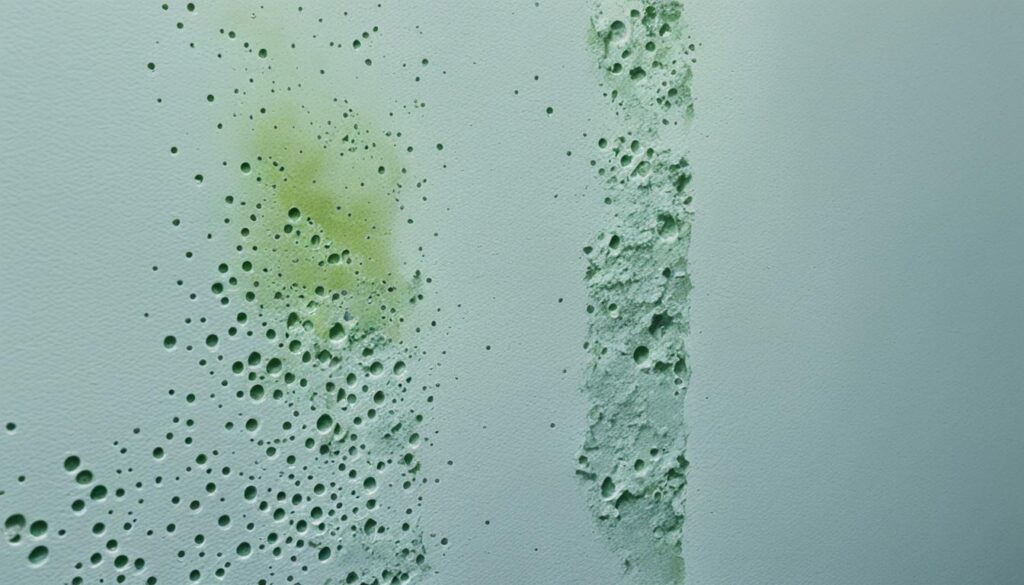
DIY Mold Inspection Guide – Can I Carry it Out Myself?
Are you concerned about the presence of mold in your home? Wondering if you can conduct a mold inspection on your own? In this comprehensive guide, we will explore the world of DIY mold inspections and provide you with the necessary knowledge to assess mold in your home without the need for a professional.
Performing a DIY mold inspection can be a cost-effective option for homeowners who want to monitor and detect mold growth in their living spaces. By understanding the importance of regular mold inspections and learning to recognize the signs of mold infestation, you can take proactive measures to protect your home and your health.
Key Takeaways:
- Conducting a DIY mold inspection can save homeowners money by avoiding the need for professional services.
- Regular mold inspections are essential for early detection and prevention of mold-related issues.
- Signs of mold infestation include musty odors, visible mold growth, and the presence of mold-related health symptoms.
- Following a step-by-step guide can help homeowners conduct a thorough DIY mold inspection.
- DIY mold testing techniques such as surface sampling, air sampling, and bulk sampling can be utilized during a mold inspection.
Understanding the Importance of Mold Inspections
Before delving into the process of conducting a DIY mold inspection, it is essential to understand the importance of regular mold inspections. Mold can be a hidden intruder within our homes, often growing in damp and humid environments.
Exposure to mold can lead to various health risks, especially for individuals with preexisting respiratory conditions or weakened immune systems. Common symptoms associated with mold exposure include nasal congestion, coughing, wheezing, throat irritation, and allergic reactions.
Quote: “Mold is not something to be taken lightly. It can cause serious health issues if left undetected and untreated.” – Dr. Emily Johnson, Environmental Health Specialist
Early detection of mold is crucial in preventing adverse health effects and potential damage to your property. By conducting regular mold inspections, you can address any mold growth issues promptly, ensuring a safe and healthy living environment for you and your loved ones.
Furthermore, identifying the source of moisture or water intrusion that facilitates mold growth is essential for effective mold prevention. A mold inspection can help pinpoint areas in your home that may be at higher risk of mold development, allowing you to take preventive measures such as fixing leaks or improving ventilation.
Mold inspections are not limited to detecting visible mold. Often, mold can grow behind walls, under carpets, or in hidden corners, which may not be readily visible to homeowners. Professional mold inspectors utilize specialized tools and techniques to identify hidden mold growth.
Key benefits of mold inspections:
- Early detection and prevention of mold growth
- Protection of your health and well-being
- Potential cost savings by addressing mold issues before they escalate
- Identification of the source of moisture or water intrusion
- Peace of mind knowing that your home is free from mold hazards
While it’s essential to understand the importance of mold inspections, it’s equally important to recognize the limitations of conducting a DIY assessment. In the next section, we will explore the signs and symptoms of mold infestation, guiding you in determining when it’s necessary to conduct a mold inspection.
| Mold Inspection Checklist | Tools |
|---|---|
| Visual inspection of all areas and surfaces | Flashlight, magnifying glass |
| Checking for musty odors | Nose, sense of smell |
| Monitoring and measuring humidity levels | Hygrometer |
| Identifying water stains or discoloration | Camera |
| Checking for condensation on windows | Visual observation |
Signs and Symptoms of Mold Infestation
Recognizing the signs and symptoms of mold infestation is crucial in determining whether you need to conduct a mold inspection. By being aware of these common indicators, you can take proactive steps to protect your home and your health.
Mold detection without a professional:
- Visible mold growth: Look for patches or clusters of mold on walls, ceilings, floors, or other surfaces. Mold can appear in various colors, including black, green, white, or even orange.
- Musty or earthy odor: Pay attention to any unpleasant smells in your home, particularly in areas with poor ventilation or high humidity. Mold often produces a distinct musty or earthy odor that is difficult to ignore.
- Allergic reactions: Keep track of any allergy-like symptoms that worsen when you are indoors. These symptoms may include sneezing, coughing, itchy or watery eyes, congestion, or skin irritation. Mold exposure can trigger or exacerbate these allergic reactions.
- Water damage: Note any previous instances of water leaks, flooding, or high humidity levels in your home. These conditions create a favorable environment for mold growth and increase the likelihood of an infestation.
- Peeling or bubbling paint: Pay attention to any unusual changes in your home’s paint. Mold growth behind walls or underneath wallpaper can cause paint to peel, bubble, or become discolored.
It is important to remember that these signs and symptoms may vary depending on the type and severity of the mold infestation. If you notice any of these indicators, conducting your own mold inspection can help you assess the situation and determine the appropriate course of action.
“Recognizing the signs of mold infestation is the first step in protecting your home and your health. By being proactive and conducting your own mold assessment, you can take control of the situation and address any potential mold issues before they escalate.”
Step-by-Step Guide to Conducting a DIY Mold Inspection
Conducting a DIY mold inspection in your home can help you identify potential mold growth areas and assess the need for further action. By following this step-by-step guide, you can confidently carry out your own mold inspection and take necessary measures to protect your home and health.
Gather the Necessary Tools
Before starting your mold inspection, it’s important to gather the right tools to ensure an accurate assessment. Here are the essential tools you’ll need:
- Flashlight: A bright flashlight will help you examine dark and hard-to-reach areas.
- Magnifying Glass: A magnifying glass can assist in identifying small or hidden mold growth.
- Gloves: Rubber or latex gloves will protect your hands during the inspection.
- Face Mask: A face mask will help prevent inhalation of mold spores.
- Mold Testing Kit: Consider purchasing a DIY mold testing kit to collect samples for further analysis.
Identify Potential Mold Growth Areas
Begin your mold inspection by examining areas in your home where mold is most likely to grow. These areas include:
- Bathrooms: Check around sinks, showers, bathtubs, and toilets for any signs of mold or water damage.
- Kitchens: Inspect under sinks, behind appliances, and around the refrigerator for any visible mold.
- Basements: Look for signs of water intrusion, dampness, or musty odors in your basement.
- Attics: Inspect any areas with poor ventilation, leaks, or excessive humidity.
- Windows and Doors: Check for condensation or water stains around windows and doors.
Visual Inspection and Mold Testing
During your visual inspection, carefully examine each potential mold growth area for any visible signs of mold, including discoloration, fuzzy patches, or a musty odor. Take notes or photographs to document your findings.
If you suspect mold but cannot see it, consider using a mold testing kit to collect samples. Follow the instructions provided with the kit to collect surface samples or air samples for further analysis.
Document and Evaluate your Findings
Once you have completed your mold inspection and testing, it’s important to document and evaluate your findings. Consider creating a detailed report that includes:
- Locations with visible mold growth
- Areas with signs of water damage or excessive moisture
- Results from mold testing, if applicable
This documentation will be helpful if you decide to seek professional assistance or take remediation measures in the future.
| DIY Mold Inspection Checklist |
|---|
| Gather the necessary tools |
| Identify potential mold growth areas |
| Conduct a visual inspection |
| Perform mold testing, if necessary |
| Document and evaluate your findings |
DIY Mold Testing Techniques

During a mold inspection, it’s essential to employ various DIY mold testing techniques to assess the presence and extent of mold in your home. These methods enable you to gain valuable insights into the mold conditions within your living space without the need for professional intervention.
Surface Sampling
Surface sampling involves collecting samples from different surfaces in your home to identify visible mold growth. To conduct surface sampling:
- Prepare the necessary equipment: You’ll need sterile swabs, gloves, a flashlight, and sealable bags for sample collection.
- Select the sampling locations: Focus on areas where you suspect mold growth or have encountered moisture issues, such as around windows, in basements, or on bathroom tiles.
- Swab the surfaces: Gently swab the suspected areas, ensuring the swab makes contact with visible mold. Place each swab in a separate sealable bag.
- Label and document: Label each sample bag with the corresponding sampling location and date. Take photos to document the conditions and sample collection process.
Air Sampling
Air sampling helps determine the concentration of mold spores in the air you breathe. To perform air sampling:
- Prepare the necessary equipment: You’ll need an air pump, a sampling cassette or petri dish, a flow meter, and sterile sampling media.
- Select the sampling location: Choose areas with suspected mold growth or high moisture levels, such as damp basements or rooms with a musty odor.
- Set up the air sampling device: Attach the sampling media to the air pump and calibrate the flow meter as per the device instructions.
- Activate the air pump: Allow the device to run for the specified sampling time to collect air samples containing mold spores.
- Collect the samples: Carefully detach the sampling media and seal it in a sterile container.
- Label and document: Label each container with the sampling location, date, and sampling time. Document the sampling procedure and any relevant observations.
Bulk Sampling
Bulk sampling involves collecting materials that may harbor mold growth, such as drywall or carpet fragments, for a thorough analysis. Follow these steps for bulk sampling:
- Gather the necessary tools: Prepare gloves, a utility knife, and sealable containers or bags for sample collection.
- Select the sampling materials: Identify areas with visible mold growth or materials suspected to contain mold, such as water-damaged drywall, crumbling ceiling tiles, or discolored carpet.
- Collect the samples: Wear gloves while carefully cutting out a piece of the material. Place the sample in a sealable container or bag, ensuring it’s adequately contained.
- Label and document: Label the container or bag with the sampling location, date, and description of the sampled material. Document the sample collection process with photos or notes.
By utilizing these DIY mold testing techniques, you can gain valuable insights into the presence and extent of mold in your home. Remember, accurate mold detection empowers you to take necessary actions for a healthier living environment.
Limitations of DIY Mold Inspections
While conducting a DIY mold inspection can be a valuable first step in detecting mold in your home, it is important to be aware of its limitations. In certain situations, it is advisable to seek professional assistance to ensure a thorough and accurate assessment. Relying solely on a DIY approach may lead to potential pitfalls that can compromise the effectiveness of the inspection.
Here are some scenarios where it is recommended to consult a professional:
- Extensive mold growth: If you notice a large area of mold growth or if the affected area exceeds 10 square feet, it is best to contact a professional mold inspector. Experienced professionals have the necessary expertise, equipment, and protective gear to handle large-scale mold problems safely.
- Hidden mold: Mold can often lurk behind walls, under carpets, or in other inaccessible areas. Professionals have the tools and knowledge to detect hidden mold and determine the extent of the infestation.
- Health concerns: If you or anyone in your household experiences persistent respiratory symptoms, allergies, or other health issues that may be related to mold exposure, it is crucial to consult a professional. They can conduct a comprehensive assessment and identify potential sources of mold that may be affecting your well-being.
Dangers of relying solely on a DIY approach
“A DIY mold inspection can provide valuable preliminary information, but it should not replace the expertise and thoroughness of a professional mold inspection. There are certain risks associated with solely relying on a DIY assessment.”
Without the proper training and equipment, DIY mold inspections may lack accuracy and reliability. It can be challenging to distinguish between different types of mold, assess the severity of the infestation, and determine the underlying causes. Additionally, inadequate safety precautions during a DIY inspection can lead to exposure to harmful mold spores, which can pose health risks.
It is crucial to remember that a professional mold inspector, such as Fix Mold Miami, has the knowledge, experience, and tools to conduct a comprehensive assessment, identify the type of mold present, determine the extent of the infestation, and provide appropriate remediation recommendations.
| Pros | Cons |
|---|---|
| Cost-effective | Limited expertise |
| Immediate action | Limited accuracy |
| Increased awareness | Potential health risks |
While a DIY mold inspection can provide a preliminary assessment, it is important to recognize its limitations and understand when professional intervention is necessary. By combining your own inspection with the expertise of a professional mold inspector, you can ensure a comprehensive evaluation and take appropriate measures to address any mold-related issues in your home.
When to Consult a Professional Mold Inspector
While DIY mold inspections can be a cost-effective solution for homeowners, there are situations where it is necessary to consult a professional mold inspector. With their expertise and specialized equipment, professional mold inspectors can provide accurate mold detection and comprehensive assessments.
Here are some specific scenarios where consulting a professional is recommended:
- If you suspect significant mold growth or a large-scale infestation in your home.
- If you have health concerns or experience symptoms that may be related to mold exposure.
- If you are unable to locate the source of mold or the extent of the infestation.
- If you need an impartial assessment for real estate transactions or insurance claims.
Professional mold inspectors have the knowledge and experience to identify hidden mold, assess the potential health risks, and recommend appropriate remediation measures. Remember, mold can cause structural damage and pose serious health risks, so it’s crucial to rely on professionals when the situation demands it.

Choosing the Right Mold Inspection Company
When selecting a professional mold inspection company, consider the following:
- Check their credentials, certifications, and licensing to ensure they have the necessary qualifications.
- Ask for references and read reviews to gauge their reputation and customer satisfaction.
- Inquire about their inspection process, equipment, and the types of tests they perform.
- Request a detailed report of their findings, including recommended remediation measures.
By choosing a reputable and experienced mold inspection company, you can have peace of mind knowing that your home will be thoroughly assessed, and appropriate steps will be taken to address any mold issues.
Remember, when it comes to mold detection, accuracy and expertise are key. Don’t hesitate to hire a professional mold inspector when necessary to ensure the safety of your home and your family’s well-being.
Conclusion
In conclusion, conducting a DIY mold inspection is an effective and cost-saving approach for homeowners to monitor and detect the presence of mold in their homes. By following our step-by-step guide and being mindful of the signs and symptoms of mold infestation, you can proactively protect both your home and your health. Regular mold inspections are essential for early detection and prevention of mold-related issues.
While DIY mold inspections can provide valuable insights, it is important to acknowledge their limitations. In instances where you suspect a significant mold infestation or have concerns about your health, it is highly recommended to seek professional assistance. A mold inspection carried out by a skilled and experienced professional, such as Fix Mold Miami, can provide a comprehensive and accurate assessment of the mold problem, ensuring the appropriate measures are taken.
To ensure the safety of your home and the well-being of your family, a combination of regular DIY mold inspections and professional assessments is the best approach. Remember that early detection and prompt action are crucial when it comes to dealing with mold. By being vigilant and proactive, you can maintain a mold-free and healthy living environment for years to come.




